Creating and Saving Color Palettes for Version 5.3
Contents
About Creating, Saving, and Sharing Color Palettes
You may want to create and distribute custom color palettes so that you and others can build graphs that have standard sets of colors. OnePager comes with several standard color palettes which are available to all users.
Creating Custom Color Palettes
If you want to create a color palette that others can use, you must create a custom color palette. Here are the steps:
1) Open any project view and click the Project-View Properties (PVP) button and select the Edit color palettes… button in the Main tab as shown here:
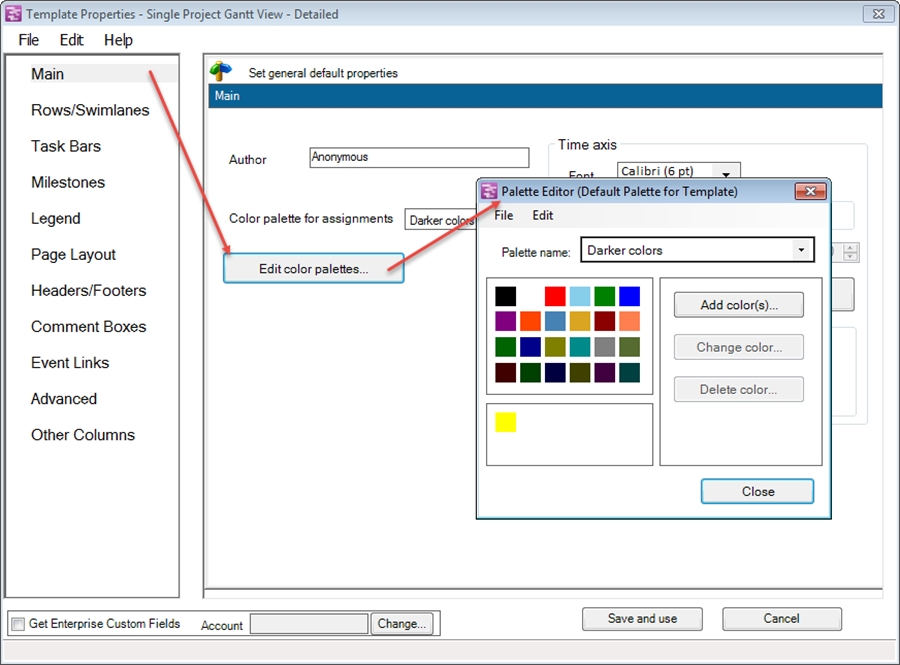
2) Select an existing palette as the starting point for your custom color palette by choosing one of the palettes from the Palette name: dropdown list:
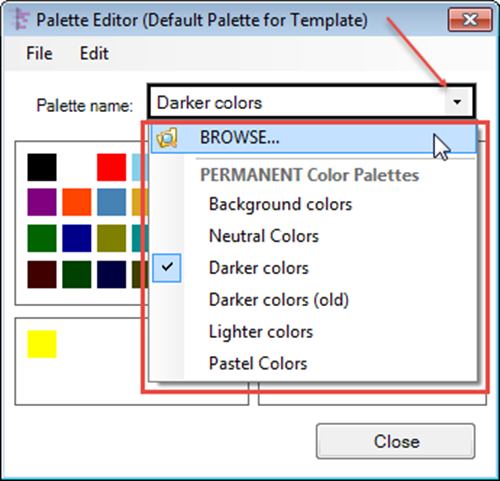
- a) You have the option to “BROWSE…” the available distributed palettes or select a palette from the drop down list. When you click on the “BROWSE…” OnePager will bring up the Open window shown below:
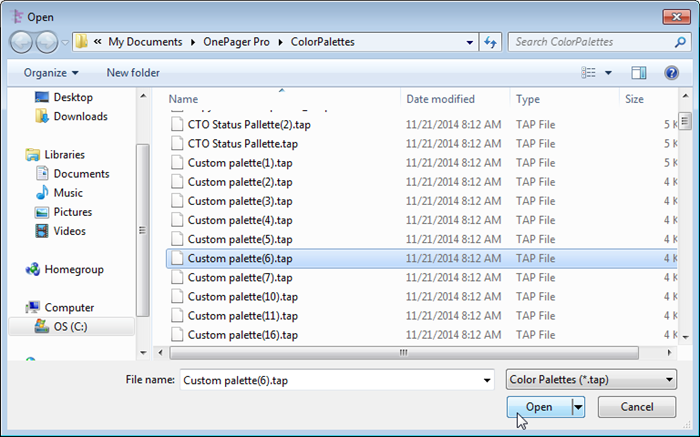
- b) Select the desired palette and click Open to make the selected palette the current palette.
- c) Clicking on any of the other options in the drop down list above will immediately make that selected color palette the current palette.
3) Create the custom palette by navigating to the “Palette Editor” menu bar’s “File” button and click “Save current color palette as…” command, shown below:
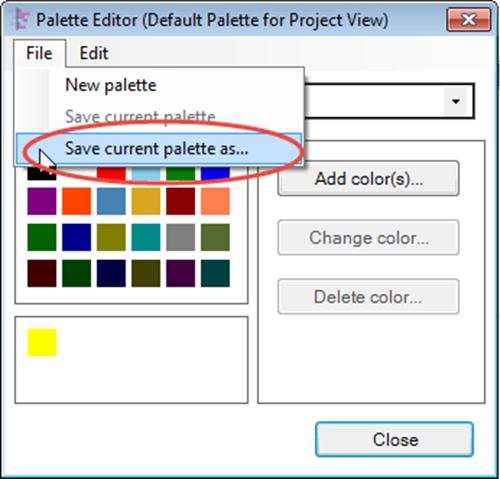
4) Clicking the “Save current palette as…” drop down menu command brings up the “Export Chronicle Graphics color palette” form where you can name your custom palette and even store it in a different folder than OnePager has previously created. The “Export Chronicle Graphics color palette” form looks like this:
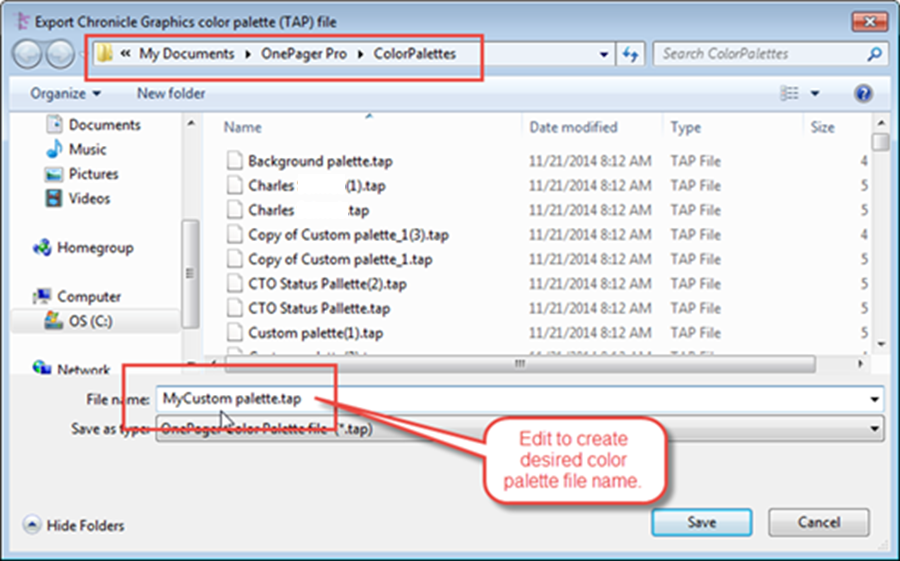
Modifying Color Palettes
You may want to add a color to an existing color palette, change a color, or delete a color from a color palette. This can be done by using the following steps:
1) Before you can make changes to an existing color palette it must be retrieved from its storage folder. To do this retrieve the “Template Properties” form for the template involved as discussed elsewhere and go to the “Main” tab and click the “Edit color palettes…” button. This will bring up the current color palette as shown below:
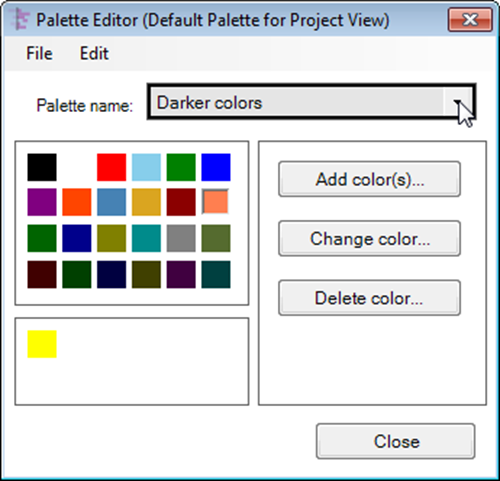
2) You have several areas where you can make a change:
Change Palette name
- a) This is done by retrieving the palette that you want to rename by using the drop down button opposite the field named “Palette name:” which gives you access to all the color palettes available by providing you access to the color palette storage folder. Clicking the drop down button reveals the following:
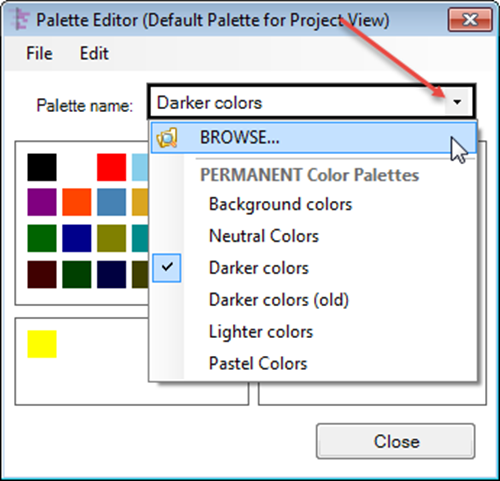
- i) You may select either a PERMANENT Color Palette to work on our BROWSE… through the folder. Clicking the “BROWSE…” command will reveal the Windows Open form for the color palettes as shown here:
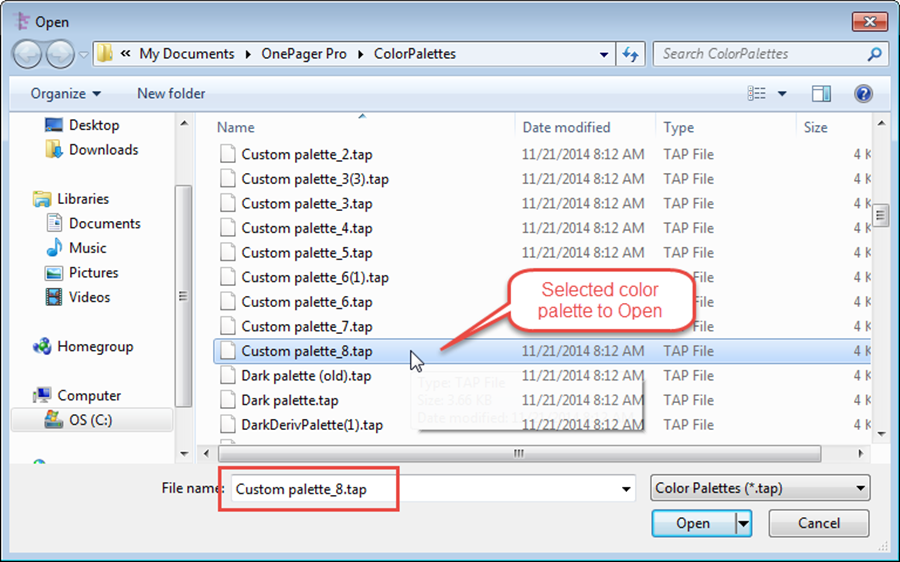
- ii) When the desired color palette is selected, click the “Open” button and this color palette will become the current color palette for editing purposes.
- iii) Then use the “Save current palette as…” function from the “File” drop down to save the renamed palette as shown below:
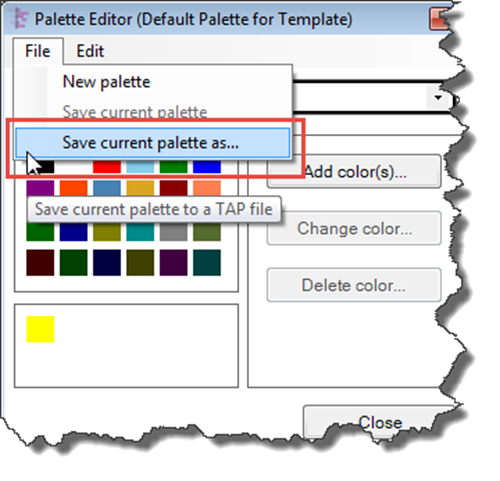
- iv) Clicking on the “Save current palette as…” option will bring up the “Export Chronicle Graphics color palette (TAP) file” form as shown below:
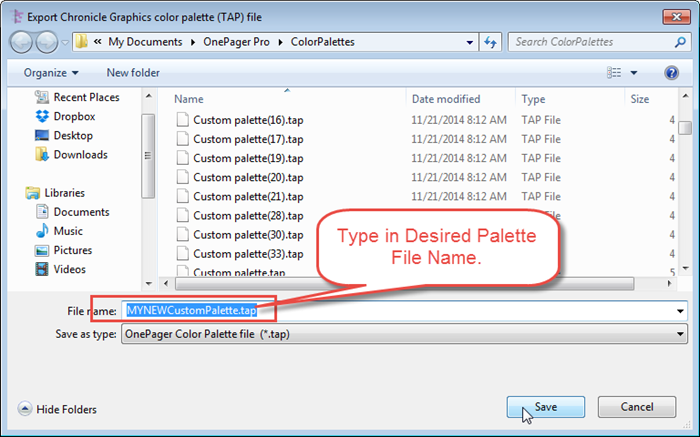
- v) Click “Save” to save your renamed color palette.
Add Colors to a Color Palette
- b) This is done by first clicking the “Add color(s)…” button in the Palette Editor. Doing this brings up the Microsoft “Color” form as shown below:
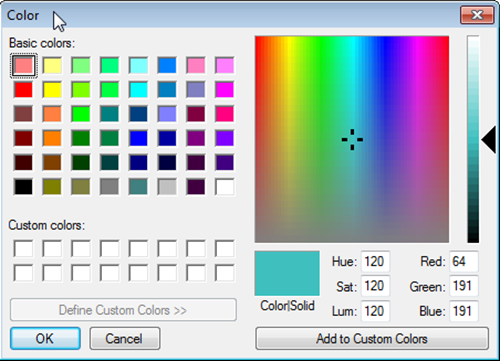
- i) There are already basic colors selected but to add your custom colors (up to 16 at a time) simply select one of the 16 “Custom colors:” boxes, place the cursor into the color spectrum area desired, move the color selector (slider arrow on the left to the desired color, click that color so it appears in the “Color|Solid” window on the form and then click the “Add to Custom Colors” button.
- ii) When this is done, the “Color” form will look like this:
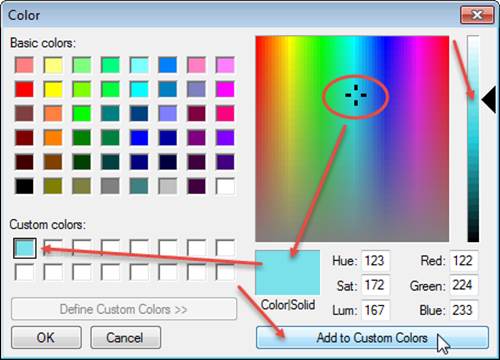
- iii) Repeat this process until all the new colors are selected. You can add up to 16 colors at a time before clicking “OK” to post the new colors into the color palette. At the end of the process described here the custom palette will look like this:
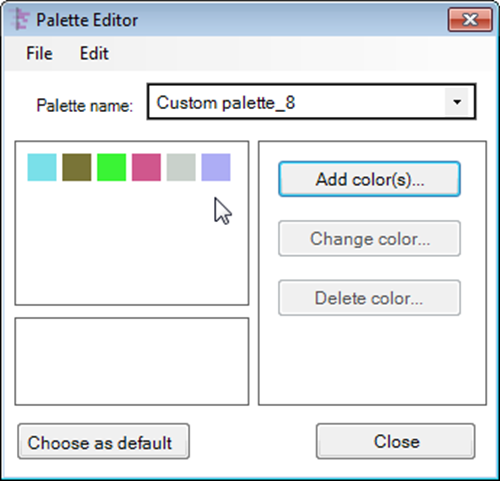
- iv) When you click the “Close” button the process is complete. You will be asked if you want to save the color palette that was changed. Answer “Yes” or “No” to this question and OnePager will take the appropriate action.
- v) As shown above, you have the option to cause the color palette you just modified to become the default color palette by clicking the “Choose as default” button. If so selected, in this example, Custom palette_8 will become the default palette for all color operations including round-robin color selection and other color related feature functions in OnePager.
Changing Colors in a Color Palette
- c) To change a color within a color palette first bring the desired color palette up so that it is visible. Then use the steps below:
- i) In the “Palette Editor”, on the left in the graph below, click the color that you want to change (1) and then click the “Change color…” button (2). This will bring up the “Color” form as shown below on the right:
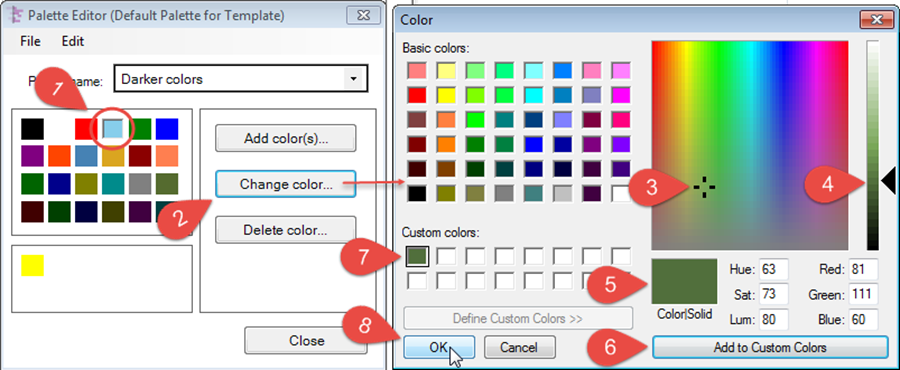
- ii) Select the color that you want to change to as discussed above in the “Color” form (3, 4, and 5).
- iii) Then, click the “Add to Custom Colors” button (6) so that it appears in the top left-most box in the “Custom colors” group on the “Color” form (7).
- iv) Finally, click “OK” (8) and the changed color will appear in the selected box of the “Palette Editor” form as shown in the sequence below:
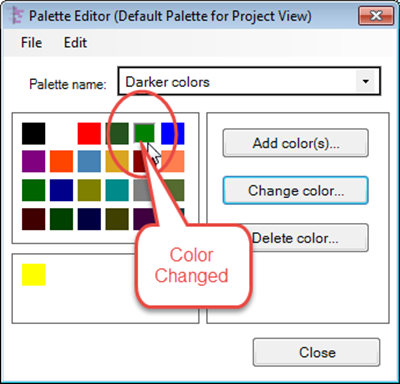
- v) After the color is changed, click “Close” and the new color will become part of the selected color palette.
Deleting a Color
- d) To delete a color from a color palette, first bring up the color palette into view.
- i) Next, select the color box that has the color to be deleted and then click the “Delete color…” button as shown below:
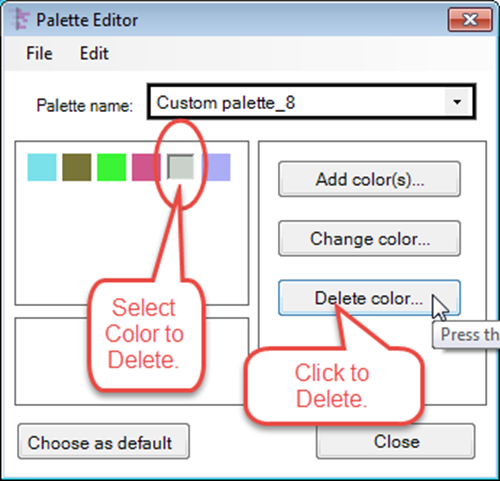
- ii) “Close” to complete the action.
Deleting Color Palettes
Since color palettes are stored by OnePager the same way that project views, and templates which means that deleting a color palette can be done by going to the folder where the color palettes are stored, selecting the correct color palette to delete and using your Delete Key to delete the file. Just follow the steps described below:
1) First access the color palette file as shown below:
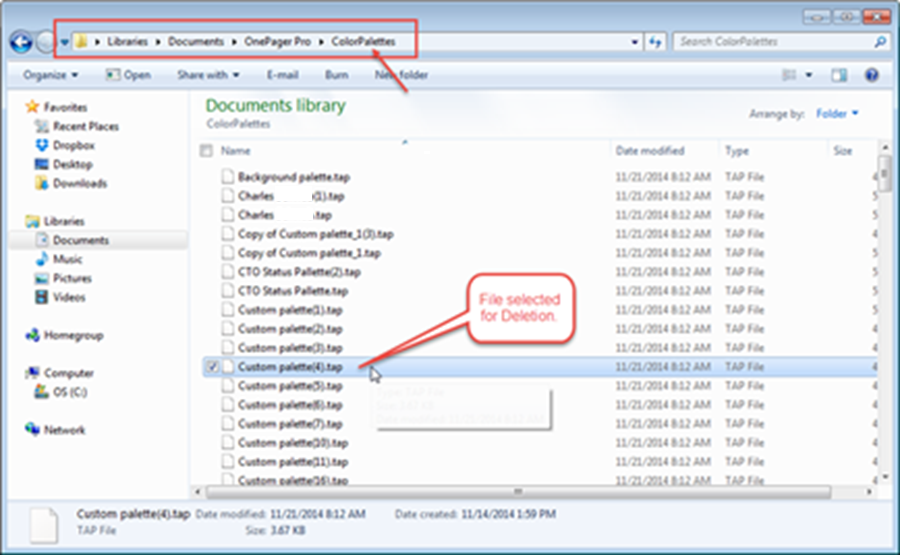
2) Once the color palette file for deletion is selected, press your keyboard’s Delete Key or right click the selected file and click the “Delete” command.
Sharing Color Palettes
Project views are represented in your computer as a .TAM file and Templates are represented as .TAT files. Whenever you create a project view there is a color palette associated with it and stored within the .TAM file. The same holds for named Template files (.TAT files). These color palettes are the default palette for the project view or template in which they are stored and “travel” with the project view or template where ever it might go.
If you build “custom color palettes” or import them from elsewhere, these are stored in the ColorPalettes subfolder folder under the same overall folder as your project views, templates, and custom milestone symbols. Custom color palettes are stored in TAP files, where they are then accessible to be used in creation or modification of project views.
There are no special actions required to distribute a default palette other than to export a template or project view as discussed above. Whenever you export any template in a TAT file or project view in a TAM file, default palette will be included in the exported file.
When the project view or template is imported at the destination, will be stored in the ColorPalettes folder as a TAP file and will be available to select from the “Edit color palettes...” button.
You may at any time access any custom color palette file (.TAP) in the ColorPalettes folder and export them in any available fashion (e.g., email attachment) to any other OnePager user.
(25.0.1-53)